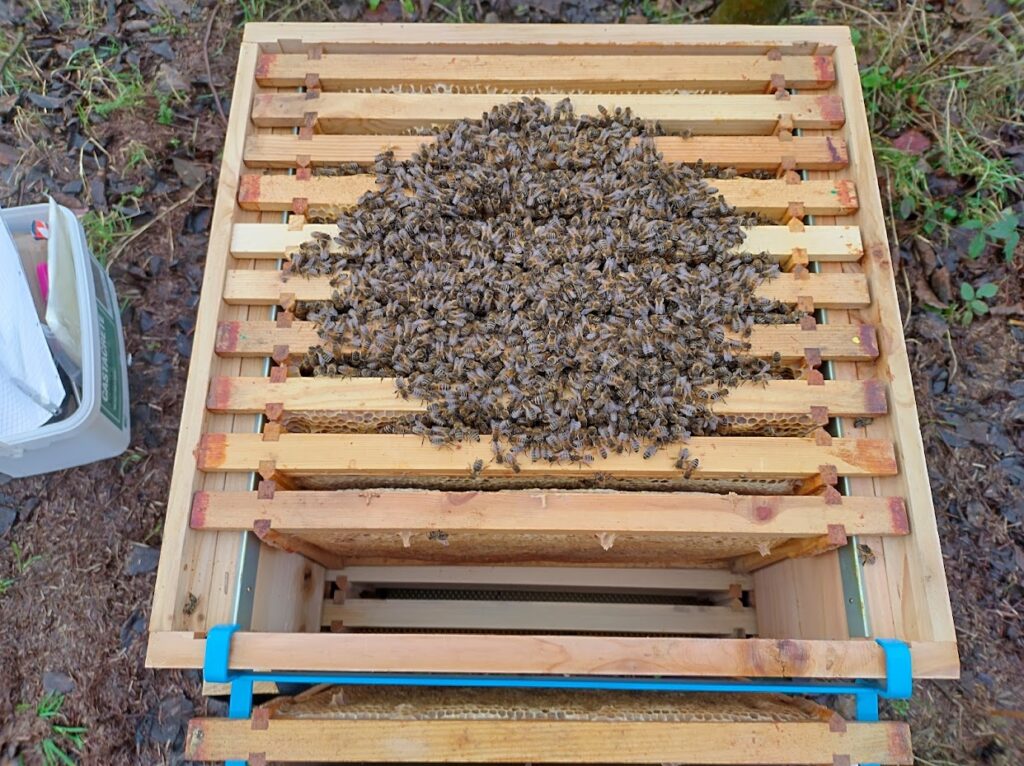When bees swarm, the sky darkens and 25,000 bodies merge into a buzzing cloud. For some, this sight is awe-inspiring. For others, it’s terrifying enough that it seems to herald the impending apocalypse. If you’re a beekeeper and this awe-inspiring apocalyptic cloud is emerging from your hive, the sight may well have you crying “Nooooooooo! Come back!”.
So, how do you collect a swarm?
Don’t try to push thousands of flying bees back in. Wait until they’ve settled somewhere, often on a tree branch, near to the hive. This is a temporary repose – it could be as brief as an hour – but it’s your window of opportunity. The swarm is sitting there while their scouts find a suitable place for them to live. You’re going to direct them to a home in your apiary. Don’t dawdle.
You need to get the bees out of the tree or off the fence post or wherever it is they’ve clustered and ultimately guide them into the hive you’ve prepared for them.
First of all, dress for the occasion. Swarms are rarely aggressive because their stomachs are so full of honey that they don’t need to eat again for days, but trying to manhandle thousands of bees without protective clothing is just asking for trouble.
Next, set up a large white sheet on the ground near the sojourning swarm. Place a box or a skep on the sheet. (A skep is a wicker beehive that looks a lot like a snake charmer’s basket!)
Now you need to approach the swarm. This may involve climbing a ladder if they’re up a tree. Do what you need to do to get close. You’ll have to evaluate their position and figure out how best to move them into your container. Can you shake them into the skep from the branch? Do you need to cut the branch and carry it to the box? Will brushing them from the fence post using your gloved hands be the best strategy?
Did you get them all? If yes, great! If no, make your container look dark, secluded and inviting. To do that, gently turn your container upside down and prop up one side to create an entrance. The bees you have collected will hopefully decide this is just what they were looking for. They’ll use pheromones to communicate to the rest of the family that a new home has conveniently appeared and everyone should move in.
Once the whole cluster is contained in your box/skep, wrap it in the sheet and head to the hive. The beekeepers who watched half their colony flying away won’t have to travel far. But if you’re a beekeeper who happened upon this swarm and wants to offer the bees a comfortable home, you may have a longer journey ahead of you. Either way, travel carefully and keep that sheet tightly wrapped around the container.
Did you all survive the journey? Is the hive ready?
I’m sure the bees are keen to move in, but they also like to feel independent. So, the kindest way to get the bees inside the hive is to open the sheet just outside and let them find the entrance themselves. If you can locate the scouts and the queen and get them to the front of the queue, the rest of the swarm will instinctively follow. Doing it this way lets the bees feel it was their choice to take up residence here, so they’ll more quickly feel at home.
Or, you could unceremoniously shake the bees from the container straight into the hive.
If you’re the beekeeper who discovered a wild swarm and decided to adopt them, it’s important to be aware of the possibility of disease. If you can, keep them away from any other colonies under your care. An ‘isolation apiary’ is ideal in this situation. Once these bees have consumed all the honey in their stomachs and you’ve been able to confirm they’re in good health, you can welcome them into your main apiary.
After a couple of days, feel free to feed your new colony sugar syrup to give them a boost of energy to establish themselves. Keep an eye on them because they may rapidly expand and, before you know it, they’ll have filled up the space and need an additional super.
You did it! You have a new colony!
A note to anyone like me: If you’ve spotted a swarm and don’t want to deal with it yourself, you could simply leave the bees alone, let the scouts do their job and wait for the bees to move into their new home. Or, if you have concerns for any reason, contact the British Beekeeping Association who will send a swarm collector to rehouse the honey bees. The collector will most likely be a local beekeeper so, while they’re there, you may as well ask about buying a jar of honey!

